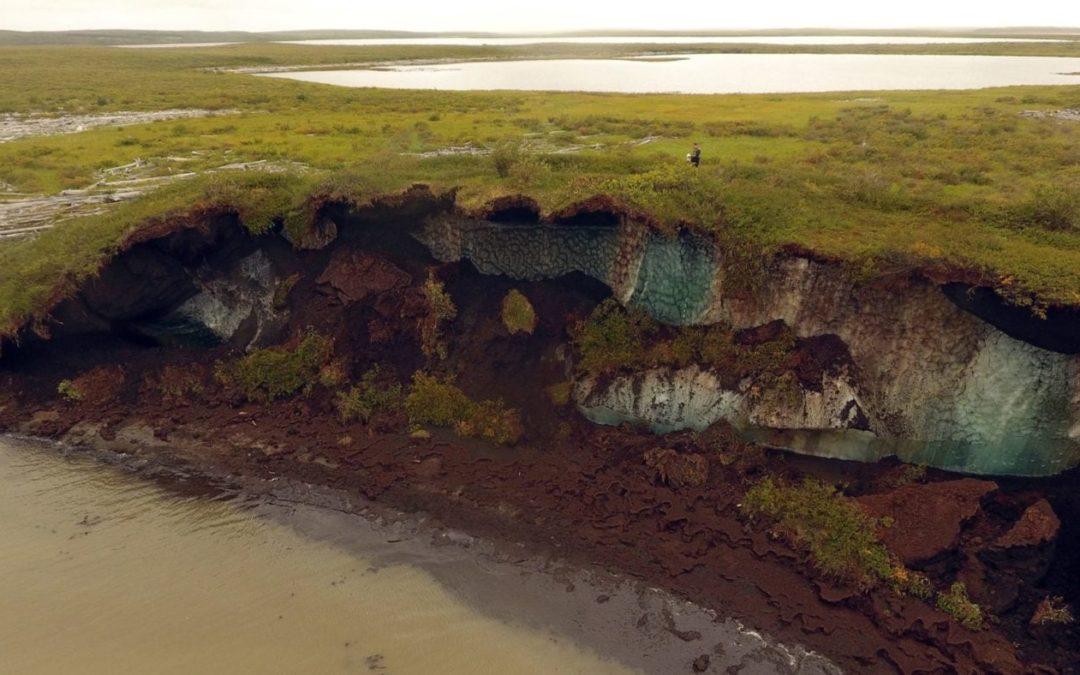SOURCE: The Narwhal
DATE: March 11, 2020
SNIP: The tundra of the western Canadian Arctic has long been carpeted in cranberries, blueberries, cloudberries, shrubs, sedges, and lichen that have provided abundant food for grizzly bears, caribou, and other animals.
Now, however, as permafrost thaws and slumping expands, parts of that landscape are being transformed into nothing but mud, silt, and peat, blowing off massive amounts of climate-warming carbon that have been stored in the permafrost for millennia.
What we do know is that if the Arctic continues to warm as quickly as climatologists are predicting, an estimated 2.5 million square miles of permafrost — 40 per cent of the world’s total — could disappear by the end of the century, with enormous consequences. The most alarming is expected to be the release of huge stores of greenhouse gases, including methane, carbon dioxide, and nitrous oxide that have remained locked in the permafrost for ages. Pathogens will also be released.
But less well appreciated are the sweeping landscape changes that will alter tundra ecosystems, making it increasingly difficult for subsistence Indigenous people, such as the Inuit, and Arctic animals to find food.
The disintegration of subterranean ice that glues together the peat, clay, rocks, sand, and other inorganic minerals is now triggering landslides and slumping at alarming rates, resulting in stream flows changing, lakes suddenly draining, seashores collapsing, and water chemistry being altered in ways that could be deleterious to both humans and wildlife.
“We’re seeing slumping along shorelines that can drain most of the water in a lake in just days and even hours,” says Canadian scientist Philip Marsh, a former Canadian government scientist who is now a professor of hydrology at Wilfrid Laurier University in Ontario.
“It’s not surprising when you consider that as much as 80 per cent of the ground here consists of frozen water. When that ice melts, the frozen ground literally falls apart.”
Marsh’s research in the Canadian Arctic has already led him to conclude that climate warming will result in hydrological changes this century that will dry up 15,000 of the 45,000 lakes in the Mackenzie River Delta, one of the largest deltas in the world.
He also expects to see more of what Antoni Lewkowicz, a geographer and permafrost expert at the University of Ottawa, is seeing father north on Banks Island in the High Arctic of Canada. Lewkowicz recently reported a 60-fold increase in slumping along 288 lakes that he has monitored with satellite imagery from 1984 to 2015.
Slumping can occur with sudden catastrophic force.
In one notable case that was captured on time-lapse photography in 2015 by Steve Kokelj, a permafrost expert with the Northwest Territories Geological Survey, a rapidly thawing cliff bordering the shores of a tundra lake collapsed into the Peel River watershed in the Northwest Territories. The waterfall that was created drained approximately 800,000 gallons of water from that upland lake in just two hours.
Heavy metals in the permafrost, such as mercury, were flushed downstream along with silt and peat, tainting the river system for miles downstream.
The rapid thawing of permafrost has enormous implications for climate change. There are an estimated 1,400 gigatons of carbon frozen in permafrost, making the Arctic one of the largest carbon sinks in the world. That’s about four times more than humans have emitted since the Industrial Revolution, and nearly twice as much as is currently contained in the atmosphere.
According to a recent report, a 3.6-degrees Fahrenheit (2 degrees Celsius) increase in temperature—expected by the end of the century—will result in a loss of about 40 per cent of the world’s permafrost by 2100.
Scientists suspect that some of the slumping may be giving new life to pathogens capable of killing muskoxen, caribou, and nesting birds as warmer temperatures nudge the pathogens out of their dormant state. Massive die-offs of muskoxen on Banks and Victoria islands in Canada, as well as reindeer in Siberia, appear to be related to once-dormant pathogens that are coming back to life.
Scientists are also finding that hundreds of sumps excavated by the oil and gas industry in the 1970s and 1980s are now thawing. Toxic petroleum waste that was supposed to be permanently contained in 200 frozen pits in the Mackenzie Delta, for example, is migrating into nearby freshwater ecosystems.

